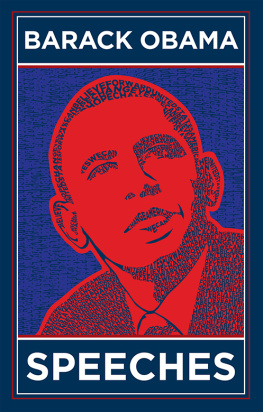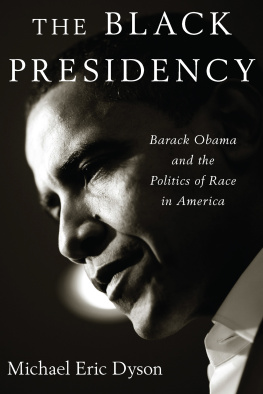
INTRODUCTION
I LEARNED HOW TO COVER RACE RIOTS BY TELEPHONE. THEY DIDN'T pay me enough at my first newspaper job to venture onto the grounds of South Boston High School when bricks were being thrown. Instead, I would telephone the headmaster and ask him to relay to me the number of broken chairs in the cafeteria each day. A white colleague dispatched to the scene would fill in the details for me.
I've spent thirty years in journalism since then chronicling stories like thatplaces where truth and consequences collide, rub up against each other, and shift history's course. None of that prepared me for 2008 and the astonishing rise of Barack Obama.
It is true that he accomplished what no black man had before, but it went further than that. Simply as an exercise in efficient politics, Obama 08 rewrote the textbook. His accomplishment was historic and one that transformed how race and politics intersect in our society. Obama is the leading edge of this change, but his success is merely the ripple in a pond that grows deeper every day.
When people do something that they've never done before, I think that makes it easier to do it a second time, David Axelrod, the Obama campaign's chief strategist, told me just days after Obama won. So when people vote for an African American candidate, I think it makes it easier for the next African American candidate.
The next African American candidates (and a fair share of those already in office) subscribe to a formula driven as much by demographics as by destiny. When population shifts occurbrought about by fair housing laws, affirmative action, and landmark school desegregation rulingspolitical power is challenged as well. It happened in Boston, New York, Chicago, and every other big city reshaped by an influx of European immigration. It is happening again now in Miami and Los Angeles, in suburban Virginia and rural North Carolina, where the political calculus is being reshaped by Latino immigrants. With African Americans, freighted with the legacy of slavery and the pushback from whites who refuse to feel guilty for the sins of their ancestors, the shift has been more scattered and sporadic, yet no less profound.
When I began my journalism career at the Boston Herald American in 1977, Boston was awash in the sort of racial drama that foreshadows dramatic change. While I was attending Simmons College, the federal courts demanded that the city's very political school committee fix the city's racially unbalanced education system.
The solution, imposed by U.S. District Court judge W Arthur Garrityin 1974, seemed pretty straightforward: send white children to schools in black neighborhoods and black children to schools in white neighborhoods. It came to be known as forced busing. The idea was to impose balance where it no longer existed. The optimistic reasoning was that the resourcesteachers, textbooks, shared experience would follow. But history now shows us that busingmoving twenty thousand students to and fro in search of quality educationwas, in fact, a far more radical notion than originally envisioned. It struck at the heart of neighborhood and racial identity in cities all over the nation, most memorably so in Irish South Boston and black Roxbury White residents of insular neighborhoods railedsometimes violentlyagainst the incursion into their neighborhood schools. Black residents in Roxbury railed right back.
As I walked to my college classes in Boston's Fenway neighborhood that fall, I saw the result with my own eyesBoston's finest in riot gear stepping in to prevent clashes at English High School. It was a scene that played out again and again all over the city, all over the country.
The white kids don't like black kids and black kids don't like white kids, a white student said after one of the melees I covered by phone. All of it is prejudice. All I know is that no one's getting any education.
It's a perfect example that forced desegregation and forced busing does not work, Elvira Pixie Palladino, an anti-busing member of the school committee, told me at the time.
White students fled the city schools during those years, so many that the majority-white city's education system became majority-black within a decade. By 2000, only a quarter of the city's children were white, and white children accounted for under 14 percent of enrollments in the city's elementary schools.
It took some years, and a more sophisticated understanding of how race and poverty intersect, for me to begin to understand that what I saw in Boston was about more than just black and white kids not liking each other. It was the beginning of a power shift that was defined by, but not limited to, race.
I moved to Baltimore in 1981, where the tipping point I had witnessed taking shape in Boston was a little further along. When I arrived, the city's leaders were still mostly white, but 56 percent of the city's residents were already nonwhite, a number that grew to 64 percent by 2000.
On the surface, Baltimore's political vibe was less charged than Boston's, but the power shifts were no less significant. The city's paternalistic mayor, William Donald Schaefer, had revived downtown with a national aquarium and a Disney-like harbor development that brought tourists in droves. Twin baseball and football stadiums were poised to sprout on downtown's southern edge. Gleaming condominiums and hotels replaced what had been run-down waterfront docks. Schaefer was hailed in national magazines as an urban savior. Howard Cosell told a Monday Night Football audience that Schaefer was the genius mayor.
But not far from the glittering downtown development most convention visitors saw, the picture was more complicated. Crime was climbing. The schools were sliding. And change was in the offing.
Schaefer, an unmarried curmudgeon used to getting his own way, was suspicious of change. And he was doubly suspicious of any call for change that seemed rooted in racial claims. That meant that he would also be suspicious of me, a black woman whose job it was to ask him questions he did not like. As he growled and snapped at meand, honestly, at most other reporters tooI came to realize what I was witnessing: the friction that is a necessary by-product of sandpaper change.
In 1983, Billy Murphy, a black judge and scion of a prominent local family, decided to use the sandpaper. Schaefer was still immensely popular, but he was also aware that new minority majorities had recently swept black mayors into office for the first time in cities such as Atlanta, and that the barrier was about to fall that year in Philadelphia as well.
In the end, Murphy turned out to be a pretty inadequate Democratic primary candidate, disorganized and unfocused. Even though Andrew Young (then mayor of Atlanta), Martin Luther King III, and comedian and activist Dick Gregory came to town to campaign for Murphy, Schaefer still managed to snare fully half of the black vote in a majority-black city
In defeat, though, Murphy's challenge was enough to open some eyes to the possibility that the mayor for life, as Schaefer had been dubbed, might be displaced. Perhaps it was time for a candidate who looked like most of the people who lived in the city. Schaefer hated this line of reasoning, openly detested Murphy, and refused to speak his name aloud. Still, he saw the handwriting on the wall.




















